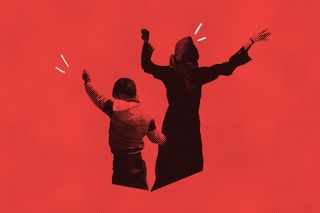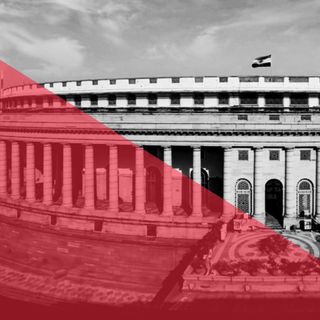.jpg?rect=0,80,1280,1280&w=320&h=320&fit=min&auto=format)
We Have to Retire the Phrase ‘Women and Children’ in Conflicts
The phrase implies that women and children together comprise one vulnerable group -- and undermines the former's political agency.

Amid global calls for a ceasefire in Gaza, one dominant justification is the toll that the genocide is taking on women and children — the stereotypical victims in any kind of crisis. Israel, too, is routinely invoking rhetoric -- and unverified claims -- about women and children to reinforce the impression of Hamas being "barbaric."
The phrase "women and children" -- often invoked in discussions surrounding conflicts, wars, and humanitarian crises -- might be well-intentioned; its objective is to emphasize the vulnerability of certain groups. However, it inadvertently has counterproductive consequences – reducing women to "victims," and men to "protectors" and "perpetrators."
In doing so, the gendered rhetoric neglects the complexity of individual experiences during conflict, sieges, and violence, making it far from an intersectional feminist approach.
There is an implied vulnerability and helplessness often associated with “women and children." And while women and children are disproportionately affected by conflict in unique ways, framing the issue thus implies that women and children together comprise one vulnerable group, rather than two distinct groups. This undermines the role of women in peacekeeping and protection during ongoing conflict and violence. Scholars argue that it also erases women's agency as human subjects with inherent fundamental rights, rather than objects of protectionism. “The idealization does not protect women from violence, but on the contrary makes them more vulnerable,” according to political scientist Maud Eduards. Not only does it undermine women’s roles in shaping peace, conflict resolution, and safety – it also serves as a rhetorical tool for aggressors to justify conflict and aggression in the first place. The framing also erases the specific and distinct types of violence and harm that women and children undergo separately.
“Women are associated with children because they are, in fact, regarded as children… Their evacuation from the theatres of devastation and war goes hand in hand with the evisceration of their political agency,” writes academic Patricia Vieira in Al Jazeera. It could further have consequences by way of distinguishing women and children deserving of safety, versus those who aren't: as political theorist Erica Burman notes: “[T]his position of ‘deserving victim’ relies on a notion of innocence that not only strips away agency but also pathologizes those who do not appear so innocent.”
Moreover, scholars have also noted that the concept of "protectors" and "protected" lends greater credence to the prevailing belief that the protectors – typically, men – are more rational and strategic, while the protected – often, women – are in need of guidance and protection. It becomes an instrument, then, to justify state secrecy: by limiting access to national security discussions only to those deemed ‘manly’ and rational.
“This masculinization of the protector and its necessary feminization of the protected has far-reaching implications,” Cynthia Enloe, an American political theorist, feminist writer, and professor, had written in her 2007 book, Globalization and Militarism. “In any patriarchal society, the protectors are deemed to be the most worldly, and thus natural controllers of the feminized protected not merely because they are stronger than the protected but because they are (allegedly) smarter. They can act ‘for their own good.’” Enloe argues how this excludes “virtually all women… from the ‘top secret’ inner circles of national security.” Besides perpetuating harmful stereotypes, then, the narrative is – perhaps, indirectly, but in practice – largely exclusionary, too.
This is despite the fact that in October 2020, “the crucial role of women in the prevention and resolution of conflicts and in peacebuilding and confidence-building, the importance of their full, equal and meaningful participation and full involvement in all efforts for the maintenance and promotion of peace and security,” was recognized, according to the UN. Yet, women continue to be perceived as the “protected.”
The framework diminishes women's agency and contributions to peace and conflict resolution efforts and fails to acknowledge their roles as first-responders, political leaders, activists, and peacemakers. Focusing solely on their vulnerability, then, unfairly takes away focus from their active participation in efforts to prevent and resolve conflicts, and to respond to ongoing crises.
In addition, it dismisses the safety and well-being of men, too. By conceptualizing women and children as most in need of protection, the narrative frames men as acceptable military targets – despite being civilians themselves. In fact, conflicts force men to confront unique challenges distinct from that of women – ranging from conscription to torture to displacement. Men – even younger men – are thus the last priority in evacuation operations, leading to a situation wherein a deliberate targeting of a group on the basis of race, ethnicity or other factors is inadvertently successful when men from those groups are viewed as targets not worth saving.
For instance, in Gaza itself, the Israeli military has had a bloody history of framing adult men as part of the Fedayeen, or guerilla resistance, and killed them onsite with little evidence. "In November 1956... Israeli soldiers entered Khan Yunis and collected all adult males from their homes and shot them at their doorsteps and in the streets, killing 520 people," notes Jacobin magazine. Many of these men were teachers, doctors, and regular unarmed civilians, as graphic novelist Joe Sacco depicted based on oral testimonies from survivors. Yet, the specific exclusion of women and children made men vulnerable to mass killings in the name of security.
Not only that, but the framing also hinders support for men who experience trauma, while serving to discourage them from seeking help due to societal expectations of stoicism, too.
However, given that we live in a society that’s been deeply conditioned by patriarchal values, there remains one merit to the gendering of the language of humanitarian crises. Charli Carpenter, a professor specializing in international law and human security at the University of Massachusetts-Amherst, who otherwise believes that the “'women and children' narrative undermines the moral logic of the civilian immunity norm,” also acknowledged in a 2005 paper: “[M]any believe that warring parties, the global media, transnational constituencies and partners in the international women's network will all be more receptive to their message if it is couched in terms of protecting ‘women and children’, specifically… while it may reproduce harmful gender stereotypes, these problems are outweighed by the gains in access to needy populations and the benefits of getting ‘civilians’ on the international agenda.”
To the extent of a cost-benefit analysis favoring humanitarian efforts, perhaps, the gendered rhetoric is justified. That doesn’t, however, mean we continue to perpetuate it without attempting to address the core biases that force us to resort to this narrative – doing so, simply serves to reinforce gender stereotypes. In the current global climate marked by militarization, reevaluating this assumption – rather than feeding it further – is absolutely urgent.
Devrupa Rakshit is an Associate Editor at The Swaddle. She is a lawyer by education, a poet by accident, a painter by shaukh, and autistic by birth. You can find her on Instagram @devruparakshit.
Related
.jpg?rect=0,80,1280,1280&w=320&h=320&fit=min&auto=format)

Is the Women’s Reservation Bill Really as Progressive as it Seems?
